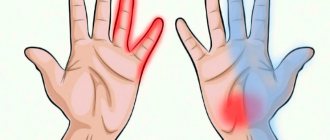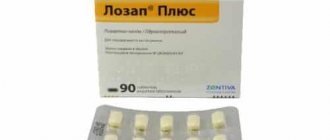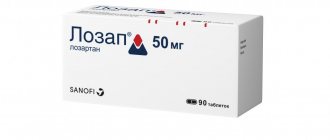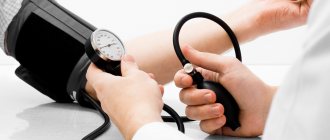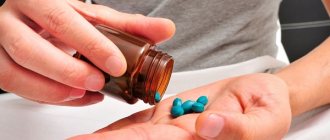Headache accompanies up to 4% of adults in the world more than 15 days a month; 30% of the world's inhabitants aged 18-65 live with migraine, reports WHO.
Migraine attacks are relieved by medications. But the effect of the pills is the opposite: the headache gets worse.
We will look at what medications and why they provoke painful conditions below.
The effect of the drugs can be negative and as a result the headache intensifies.
Medicines prescribed for migraines
Scientists from Moscow State Medical University named after. THEM. Sechenov named groups of drugs for the treatment of migraine:
- painkillers, analgesics, anti-inflammatory drugs (NSAIDs): aspirin, ibuprofen, naproxen, acetaminophen;
- ergot: combination medications containing caffeine and the painkiller ergotamine;
- triptans: drugs that constrict blood vessels;
- combination analgesics: include combinations of acetaminophen, aspirin and caffeine.
These medications, when used frequently, may not alleviate headaches, but may worsen them. Drug-induced migraine develops.
Be careful when choosing medications; it is best to consult a doctor.
Convulsions
You might think that seizures occur only with epilepsy. Therefore, when they appear, anticonvulsants are definitely needed. In addition to epilepsy, there may be many other conditions that have nothing to do with it, but which may be accompanied by seizures:
- Cerebrovascular disease, age over 75 years, and hemorrhagic strokes often cause the onset of acute symptomatic seizures.
- Traumatic brain injuries.
- Infectious diseases of the central nervous system (meningitis, encephalitis, HIV infection).
- Oxygen starvation of the brain.
- Intoxication of the body.
- Taking medications.
- Acute metabolic disorders, for example, hypoglycemia in the treatment of diabetes mellitus, electrolyte imbalance.
- Withdrawal syndrome when stopping alcohol consumption.
- Taking large doses of alcohol.
- Taking psychotropic drugs (psychotropic stimulants - cocaine, crack, ecstasy).
- Temperatures above 38.5°C in children under 7 years of age can cause febrile seizures.
- Liver failure.
- Parkinson's disease.
Therefore, self-administration of anticonvulsants without a doctor’s prescription is prohibited. First you need to establish the cause of the problem and only then treat it.
Causes of drug-induced migraine
Medicinal migraine occurs when painkillers are abused, explains neurologist at the Headache and Autonomic Disorders Clinic, Academician Alexander Vein, Associate Professor of the Department of Nervous Diseases of Moscow State Medical University. THEM. Sechenova Nina Latysheva. Taking analgesics more than twice a week is addictive. The lifespan of the tablet is reduced. A person takes analgesics more often and becomes dependent.
Symptoms of headaches from the reverse effect of analgesics were described by a group of Russian scientists from the Moscow Federal State Budgetary Institution "Scientific Center of Neurology" and the Federal State Budgetary Educational Institution of Higher Education "Moscow State Medical and Dental University named after. A.I. Evdokimov." This pain is daily and varies in intensity. Pain increases with physical or emotional stress and discontinuation of medications.
It is not always easy to identify the causes of migraine, and sometimes it is impossible without a full examination.
Doctors at Germany's Essen University Hospital have described drug overuse as a global problem, with up to 4% of people overusing analgesics and other drugs to treat migraines and 1% of people in Europe, North America and Asia experiencing medication-induced headaches.
In Russia, patients also face headaches due to medications. German scientists from the University of Bochum, the Norwegian University of Science and Technology and the Russian Academy of Sciences examined 2,725 adults in 35 cities and nine villages in Russia. 213 (10.5%) respondents reported headaches 15 times a month or more often, 145 of them (68.1%) abused medications.
Scientists from the American Academy of Neurology have found out how long it takes to get used to drugs. The shortest period was for triptans - 1.7 years, for ergot - 2.7 years, for analgesics - 4.8 years. Patients who overused ergots and analgesics reported daily tension-type headaches (TTH), and patients who took triptans described migraine-like headaches or an increase in migraine attacks.
Be careful, some drugs are addictive.
Epilepsy
Epileptic seizures that occur without any apparent reason two or more times can be considered epilepsy. An epileptic seizure is an abnormal or excessive discharge of neurons in the brain with visible manifestations. Visible manifestations are not always convulsions and loss of consciousness, they can be:
- only changes in consciousness;
- mental manifestations;
- motor changes;
- vegetative manifestations.
For a particular person, these symptoms can be in the form of ringing in the ears, flashes of light or flame, redness of the face, short-term disturbances in speech, memory and many others. It depends on where the nerve impulse went out of control and activated a particular area of the brain. Moreover, these changes may be first noticed by another person, and not by the patient himself. This can happen, for example, with episodes of freezing for a few seconds. If these symptoms have a clear cause, such as a head injury or a brain tumor, it is not epilepsy.
There are many forms of epilepsy depending on the type of epileptic seizures, types of epilepsy and status epilepticus (an epileptic seizure lasting more than 30 minutes at once or a series of seizures without full recovery of consciousness).
If the symptoms have a clear cause, then it is not epilepsy.
Treatment of drug-induced headaches
A drug-induced headache goes away if you stop taking uncontrolled painkillers. Scientists at the Danish Headache Center studied patients with medication overuse headaches. For two months, 216 subjects were drug-free, although 8 patients had previously abused ergot, 12 narcotics, 43 triptans, 62 painkillers, and 90 combination analgesics. After 60 days, 144 patients (67%) had reduced headache frequency.
Headache requires examination and consultation with a doctor. Competent therapy will allow you to safely stop attacks.
Take a migraine test
Questionário ID-Migraine™ eo adequado diagnostico da migrânea
Approaches to taking anticonvulsants
If previously the main goal of treating epilepsy and taking anticonvulsants was to prevent new seizures, today an integrated approach takes first place, taking into account the patient’s quality of life and maintaining his ability to work during treatment
Finding effective therapy can be difficult. This is influenced by factors such as compliance with medication regimen and side effects. Changing drugs by trade name, but with the same active ingredient, can also lead to worsening problems.
Typically, one drug is used at the beginning of treatment for epilepsy, but the dosage and medication may vary. If the desired result is not achieved, only then connect a second remedy and use various combinations.
Finding effective therapy can sometimes be difficult.
Anticonvulsants
There are 3 main mechanisms used to treat epilepsy:
- Stabilization of the membrane potential of nerve cells due to the influence on ion channels. Due to this, K+ ions remain in the cell, and Na+ ions outside. The effect can also be exerted through Ca2+ channels. This maintains “rest” on the membrane of nerve cells.
- Suppression of processes involved in excitation.
- Strengthening braking mechanisms.
Many drugs act on several mechanisms at once and it will not be possible to divide them into groups on this basis.
Medicines:
Depakine Chronosphere , Convulex , Encorat chrono . Valproic acid preparations. They have a muscle relaxant effect and enhance inhibitory processes in the brain. Absorption of the drug may slow down when taken with food. Side effects include : weight gain, hair loss, gastrointestinal problems, tremors.
Finlepsin retard , Tegretol CR , Carbatol. They belong to carbamazepine drugs and are used for grand mal seizures and mixed forms of epilepsy. Contraindications: absence and myoclonic seizures. Side effects: dizziness, drowsiness, headache, but stopping treatment often causes a skin rash.
Phenobarbital , Benzonal , Maysolin . They belong to the group of barbiturates. Can be used for any type of epilepsy attack. Often used in infants. There is a marked slowdown in mental processes. Children have the opposite reaction and develop hyperreactivity. They reduce motor activity and can cause drowsiness. The anticonvulsant effect is realized by preventing the occurrence and propagation of an impulse from the source of activity. The absence form of idiopathic epilepsy will be a contraindication for use.
Frisium , Relanium , Merlit. They belong to the group of benzodiazepines. They are especially often used for progressive myoclonic epilepsy. But over time, the effect may decrease and addiction may develop .
Lamictal , Pamolen. The active ingredient is lamotrigine. It is effective for all types of seizures, but it is recommended to avoid it for myoclonus. The main side effect is a rash, the severity of which increases sharply when combined with valproate and carbamazepine.
Topamax (topiramate). Acts on different mechanisms in preventing attacks, effective in adults and children. Start taking with minimal doses and increase slowly. Use with caution in children with speech disorders, as well as sleep problems. One of the side effects is weight loss, so it should not be used in “thin” patients.
Keppra , Levetinol . The active ingredient is levetiracetam. Optimal action for epileptic myoclonus, does not interact with other drugs. Should not be used in patients prone to agitation and sleep disturbances.
Suxilep. Previously it was the drug of choice for the treatment of absence seizures, but has now given way to valproic acid. Contraindicated for mental problems. Side effects: headache, drowsiness, gastrointestinal symptoms.
Tebantin , Neurontin , Gabapentin . Structurally similar to GABA, they are not transformed in the liver, so they can be used with many other drugs and for liver diseases. Side effects: weakness, dizziness, weight gain.
Since the treatment of epilepsy in many cases involves lifelong use of drugs, the balance between their effectiveness and toxicity is important. Drug metabolism pathways (in the liver) and interactions with other drugs in concomitant diseases also play a role. The selection of anticonvulsant drug therapy is a joint effort between the doctor and the patient.
How to choose a medicine
In fact, the most important point is which medications we take. In the figure you can see the scale of aggressiveness of various drugs from the NSAID group in relation to the stomach.
The most aggressive drugs are Aspirin, Ketorolac, Piroxicam, Indomethacin. If possible, it is recommended to use selective drugs that have minimal gastrointestinal risks. Their use is always more desirable, these include Celecoxib and Rofecoxib. But despite their relative safety, they should be prescribed strictly according to indications by the attending doctor, do not forget about this.
Read also
Trigeminal neuralgia
Trigeminal neuralgia is a chronic disease characterized by excruciating paroxysmal shooting pains in the area of innervation of one or more branches of the trigeminal nerve.
Neuralgia… Read more
Monoclonal antibodies against migraine
About 11% of people in the world suffer from migraines, and a third of them are forced to stay in bed during attacks. This significantly reduces the quality of life: it interferes with work, communicating with friends and engaging in hobbies.…
More details
Planning pregnancy in patients with migraine
In recent years, many women suffering from migraine have turned to the prevention and treatment of migraine during pregnancy. Conscious responsibility for one’s health, the desire to reproduce healthy…
More details
Orgasmic or coital headache
Orgasmic pain occurs during sex. This form of headache occurs more often in males. Symptoms of orgasmic headache: acute (paroxysmal) headache *throbbing…
More details
Cluster headache
One of the types of primary cephalgia is cluster headache ("cluster" - "bundle"). This type of cephalalgia is characterized by very intense, short attacks concentrated around the eye...
More details
What to do in this case?!
The algorithm of actions for patients who do not have stomach problems and those who have a history of peptic ulcers or erosive changes is different. For the first group, when prescribing non-steroidal anti-inflammatory drugs for more than 5 days, it is mandatory to prescribe drugs from the group of proton pump inhibitors (PPIs). Such as omeprazole, pantoprazole, rabeprazole, etc. (for the entire course of treatment). For the second group, any prescriptions from the NSAID group, regardless of the duration of use, require parallel prescription of proton pump inhibitors. It is also mandatory to take a PPI for patients taking aspirin for a long time.
"Magic" pills
There is a group of drugs collectively called non-steroidal anti-inflammatory drugs (NSAIDs), which we all have taken at least once in our lives, and many regularly. These are drugs that have analgesic, anti-inflammatory and/or antipyretic effects. Examples include Aspirin, Nurofen, Nice, Ketanov, Ketoprofen and others. Considering the “magical effects” of their action - relieving inflammation, pain and fever - they are prescribed by almost everyone, everyone, always. Prescribed by traumatologists, rheumatologists, therapists, ENT specialists, dentists. Plus, they can be purchased completely freely at any pharmacy. But, along with the “magical properties”, these drugs have a number of side effects that can be divided into 2 groups: cardio risks and gastro risks. Actually, gastrorisks will be discussed in this article.
NSAID gastropathy
In the scientific literature, this problem is called “NSAID gastropathy.” The term was first proposed in 1986 to distinguish specific damage to the gastric mucosa that occurs with long-term use of NSAIDs from classic peptic ulcer disease.
The difference between NSAID gastropathy and peptic ulcer disease can also be traced by the affected area. Most often, ulcers can be seen in the stomach, and not in the duodenum. Plus, the changes are more common in older people than in younger people.
Summary
So we draw conclusions:
- Before long-term use of NSAIDs, it is mandatory to collect an anamnesis to exclude gastrointestinal pathologies in the past, and, if necessary, perform gastroscopy, diagnosis and treatment of helicobacteriosis.
- When choosing what to treat, if possible, you should choose selective NSAIDs.
- When prescribing non-selective NSAIDs for more than 5 days and in patients with a history of erosive and ulcerative changes, even with selective NSAIDs, it is necessary to take stomach covering drugs (PPIs).
- All patients in the age group over 60 years of age who regularly take aspirin must undergo gastroscopy and, in case of high risks, constantly take drugs from the PPI group.
- Appointment with a gastroenterologist in our clinic
- 3,900 rubles
Diagnostics
To diagnose such changes, gastroscopy is used, which is the “gold standard”. An interesting fact is that about 40% of patients with erosive-ulcerative changes who take these drugs for a long time (more than 6 weeks) do not feel any discomfort or unpleasant, painful sensations. Stomach problems are diagnosed only when visiting other doctors, and not a gastroenterologist. And, conversely, in 40% of patients, despite the complaints they make, nothing is found.
Myths that we encounter in daily practice
Myth 1. Using NSAID drugs in the form of suppositories is less aggressive for the stomach than taking pills
This is 100% a myth. The pathogenic, destructive effect of the drug is realized through the blood, delivering it through the vessels to the stomach.
Myth 2. Medicines from the group of antacids - Rennie, Maalox, Phosphalugel and H2-blockers (Ranitidine and Famotidine) can be used as “gastroprotectors”
In this case they are not effective.
Myth 3. You can't take proton pump inhibitors regularly
The fact is that if an elderly person has been prescribed an anti-inflammatory drug for life, it is absolutely pointless to prescribe gastroprotection for a month. In such cases, medications should be taken strictly in parallel.
Myth 4. Food products (jelly, etc.) can act as “gastroprotectors”
We will leave this myth as absolutely fantastic without comment.
The danger of overdosing on painkillers
In some cases, when indicated, doctors prescribe opioid treatment to patients.
These are very dangerous drugs that cause drug addiction quite quickly. All you have to do is not follow the doctor’s prescription, increase the period of use and dosage specified in the instructions or allowed by the doctor, and the dependence on the pills is in your pocket.
Opioids have great analgesic activity, so their abuse can easily lead to severe poisoning and even death.
- You can't convince me to get treatment
? - We will help you with motivation for treatment. As a rule, it is difficult for loved ones to persuade or force an addict to undergo treatment. World experts have developed EFFECTIVE motivation schemes, using which you can lead an addict to the decision to seek help. 8
How it works?
How do these drugs work in our stomachs? Everything is very simple, the negative impact is realized due to the imbalance of defensive and aggressive forces. We have a number of defense mechanisms in our stomach that allow us to withstand the onslaught of aggressors. Among the latest:
- An acid whose pH balance is close to that of battery acid
- Bile and pancreatic juice, which can be thrown into the stomach.
- A number of medications.
- Alcohol and nicotine.
- Irritating food components (spices, spicy foods, etc.)
- Helicobacter pylori infection and so on.
The stomach is protected due to a thick layer of mucus and bicarbonates that neutralize acid, adequate blood supply, and the ability to regenerate very quickly. When we use NSAID drugs, the balance of forces changes towards aggressive mechanisms and damage occurs to the mucous and submucosal layer of the stomach and duodenum.
Treatment methods
Self-medication for abusive headaches is unacceptable, as it can blur the existing clinical picture and worsen the condition. When contacting a doctor, it is important to talk as objectively as possible about the nature of the pain and the medications you are taking. Concealing the fact of taking a particular group of medications leads to a distortion of the picture of the disease and the prescription of ineffective therapy. For competent treatment, it is necessary to know the doses and names of regularly used medications, since almost every patient suffering from abuse factor takes more than one medication. This is due to a decrease in the analgesic effect due to addiction. Taking medications becomes a habitual way of life for the patient.
When the usual medications are discontinued after 3-4 weeks, the patient’s condition significantly improves, the frequency of abusive pain decreases and their intensity decreases. Some patients complain of pain that preceded the development of the abuse factor.
